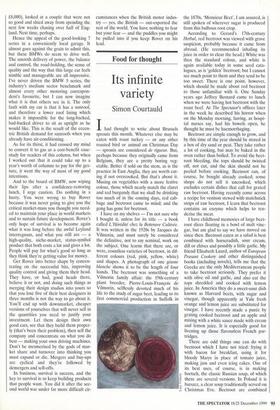Food for thought
Its infinite variety
Simon Courtauld
I have on my shelves — I'm not sure why I bought it, unless for its title — a book called L'Heredite chez la Betterave CuWI*. It was written in the 1920s by Jacques de Vilmorin, and must surely be considered the definitive, not to say seminal, work on the subject. One learns that there are, or were, countless varieties of beetroot, in dif- ferent colours (red, pink, yellow, white) and shapes. A photograph of one geante blanche shows it to be the length of four hands. The beetroot was something of a Vilmorin family affair: the 19th-century plant breeder, Pierre-Louis-Francois de Vilmorin, selflessly devoted much of his life to the study of sugar beet, leading to its first commercial production in Suffolk in the 1870s. 'Monsieur Beet', I am assured, is still spoken of wherever sugar is produced from this bulbous root crop.
According to Gerard's 17th-century Herbal, red beetroot was viewed with grave suspicion, probably because it came from abroad. (He recommended inhaling its juice in order to clear the head.) White was then the standard colour, and white is again available today in some seed cata- logues, as is 'golden' beetroot; but I cannot see much point to them and they tend to be too sweet. There is one point, however, which should be made about red beetroot to those unfamiliar with it. One Sunday years ago Jeffrey Bernard came to lunch when we were having hot beetroot with the roast beef. At The Spectator's offices later in the week he described his horror when on the Monday morning, having, as hospi- tal nurses say, had his bowels open, he thought he must be haemorrhaging.
Beetroot are simple enough to grow, and by this time of the year should be stored in a box of dry sand or peat. They take rather a lot of cooking, but may be baked in the oven rather than boiled. To avoid the beet- root bleeding, the tops should be twisted off, not cut, and the skin should not be peeled before cooking. Beetroot can, of course, be bought already cooked; some shops do not sell it uncooked, which excludes certain dishes that call for grated raw beetroot. Having recently come across a recipe for venison stewed with matchstick strips of raw beetroot, I learn that beetroot contains an enzyme which helps to ten- derise the meat.
I have childhood memories of large beet- root slices floating in a bowl of malt vine- gar, but am glad to say we have moved on since then. Beetroot eaten as a salad is best combined with horseradish, sour cream, dill or chives and possibly a little garlic. My friend Elisabeth Luard, author of European Peasant Cookery and other distinguished books (including novels), tells me that the Greeks are the only Mediterranean people to take beetroot seriously. They prefer it with olive oil and garlic, and also eat the tops shredded and cooked with lemon juice. In America they do a sweet-sour dish known as Harvard beets, with sugar and vinegar, though apparently at Yale fresh orange and lemon juice are substituted for vinegar. I have recently made a purée by grating cooked beetroot and an apple and mixing with a white sauce made with cream and lemon juice. It is especially good for livening up those flavourless French par- tridges.
There are odd things one can do with beetroot which I have not tried: frying it with bacon for breakfast, using it for bloody Marys in place of tomato juice, making jam and even icing cakes. One of its best uses, of course, is in making bortsch, the classic Russian soup, of which there are several versions. In Poland it is barszcz, a clear soup traditionally served on 3 Christmas Eve. Beetroot are combined with carrots, leeks, celeriac, dried mush- rooms, peppercorns, allspice berries and a bay leaf and simmered for an hour, then strained and the liquid reheated. Lemon juice, sugar and salt may be added, also grated raw beetroot and sour cream on top of the soup bowls. Ideal before or after the midnight service.























































































































 Previous page
Previous page